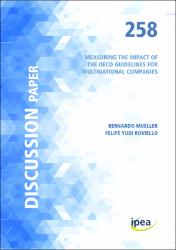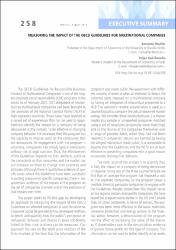Please use this identifier to cite or link to this item:
https://repositorio.ipea.gov.br/handle/11058/10764Files in This Item:
| File | Description | Size | Format | |
|---|---|---|---|---|
| dp_258.pdf | 6.02 MB | Adobe PDF |  View/Open | |
| dp_258_sumex.pdf | 112.43 kB | Adobe PDF |  View/Open |
| Title: | Measuring the impact of the OECD guidelines for multinational companies |
| Other Titles: | Discussion Paper 258 : Measuring the impact of the OECD guidelines for multinational companies Medindo o impacto das diretrizes da OCDE para empresas multinacionais |
| Authors: | Mueller, Bernardo Roviello, Felipe Yudi |
| Abstract: | The OECD Guidelines for the responsible business conduct of Multinational Enterprises is one of the largest corporate social responsibility programs (CSR) in the world. By February 2021, 501 allegations of misconduct by multinational companies have been brought to the attention of the National Contact Points (NCP) of its signatory countries. These cases have resulted in a varied sample of experiences which can be used to quantitatively identify the impact on a company of being denounced within this framework. This paper describes an approach to measure the impact of the OECD Guidelines on the affected enterprises. Because adherence to the Guidelines is voluntary, these do not have judicial force or official sanctioning mechanisms. Their efficacy depends on the impact that they have on companies’ reputation and public image. Measuring this impact is not straightforward, yet a large literature on Corporate Social Responsibility has developed many methods to detect and quantify how the public’s perception of companies’ behavior and choices in areas not directly linked to their core business can be measured. In this paper we use several variants of event studies as methods to detect potential costs imposed on a multinational company of having an allegation of misconduct brought before a NCP. These methods use stock to detect stock price if there are oscillations around the time of the denunciation. If the companies’ returns suffer due to having alleged misconduct brought before this mechanism, it is reasonable to assume that the Guidelines and NCPs are effective. The variations revolve on what is used as a counterfactual to the observed market oscillations. We consider three counterfactuals: i) a market model; ii) a sample of non-denounced companies matched along a set of covariates; and iii) the firms’ returns over an interval of placebo-dates, when they were not denounced. We find clear evidence that in many cases the firms’ exposure through the program led to a statistically significant decrease in returns at the time of the denunciation. These effects varied, however, across firms, sectors and countries. |
| metadata.dc.rights.holder: | Instituto de Pesquisa Econômica Aplicada (Ipea) |
| metadata.dc.rights.license: | É permitida a reprodução deste texto e dos dados nele contidos, desde que citada a fonte. Reproduções para fins comerciais são proibidas. |
| metadata.dc.type: | Discussion Paper |
| Appears in Collections: | Pequenas, Médias e Grandes Empresas: Livros |
Items in DSpace are protected by copyright, with all rights reserved, unless otherwise indicated.

